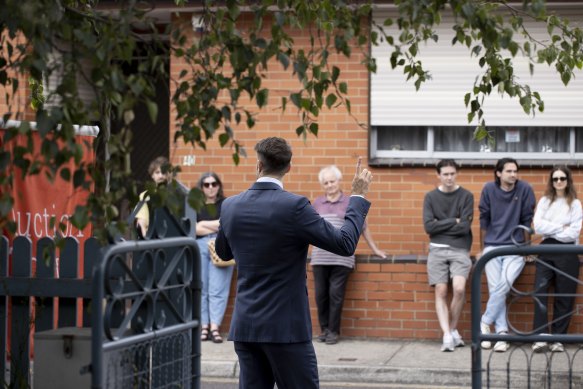‘It’s not good’: How home buying hopefuls got knocked out of the market
By Jim Malo and Elizabeth Redman
The share of highly indebted home borrowers has cratered in the wake of one of the steepest rate hiking cycles in the Reserve Bank’s history, further fuelling concerns that Australians without access to wealth have been shut out of the property market.
Only 5.2 per cent of all new home loans in the March quarter were to borrowers whose debts are at least six times their incomes. Almost a quarter of borrowers had debts this high when interest rates were at rock bottom, figures from bank regulator the Australian Prudential Regulation Authority (APRA) show.
Banks have been reducing the amount they will lend as interest rates have risen and pushed up monthly mortgage repayments. Since late 2021, they have also been forced to check that new borrowers could meet their repayments if their interest rate rose by 3 percentage points, up from 2.5 previously.
This has reduced the chances of middle-income households with skinny deposits being able to buy a home, while buyers who already have a substantial deposit can still purchase.
CoreLogic head of Australian research Eliza Owen said the stricter lending rules pulled some potential buyers out of the market straight away because they could not borrow as much, and also reduced some purchasing by investors who generally have higher interest rates than owner-occupiers.
She said average mortgage rates are now higher than in 2019, explaining the drop in highly indebted borrowers to sub-2019 levels.

Buyers with access to wealth were using it to top up deposits to be able to afford homes they otherwise couldn’t after borrowing capacities were slashed by rate hikes. Credit: Arsineh Houspian
“It’s good that we have that prudential lending environment … because APRA essentially got ahead of rate rises so they probably reduced some of the fallout in mortgage stress we might otherwise have seen,” she said.
Investors who are buying multiple properties were likely to be affected, alongside first home hopefuls.
“Lower income first home buyers also tend to be more highly indebted just because they don’t have the windfall gains that come from the sale of a property they might already own,” she said.
“So that’s where the disadvantage of these prudential policies is, they exclude people who might otherwise have been more competitive.
“The flipside of that is high debt-to-income borrowers are more likely to face mortgage stress, they typically have smaller prepayment buffers, so it also protects some of those lower-income consumers in a way. It’s the constant struggle between financial stability and accessibility of the market.”
She said buyers in the market are now taking smaller loans relative to their incomes because they have larger deposits – which is why property prices are still so high, even as interest rates have shot up. Some are selling a property and putting the capital gains towards their next home, some are wealthier or higher income, and some are first home buyers getting assistance with their deposit, she said.
Almost a third of all home-loan applicants make more than $200,000, at the expense of those on more moderate incomes, previous Jarden analysis of Commonwealth Bank data found.
CBA chief economist Gareth Aird said the drop-off in new loans with debt-to-income ratios of six and higher was closely linked to the RBA’s rate-hiking cycle.
“As interest rates go up … the amount you can borrow on a given income goes down. Which is why the DTI goes down,” he said. “But the average loan size has gone up, so it’s probably the case people on higher incomes are transacting more as a share than we saw a few years ago.
“We’ve seen a much bigger lift in lending to investors rather than first home buyers, and investors are generally higher income.”
Aird said the low percentage of high debt-to-income loans indicated that it was mostly wealthy Australians who were participating in the property market while rates were high and mortgages expensive.
“There are first home buyers [purchasing], but the share of investor activity has grown over the past 12 months,” he said. “Affordability metrics are the worst on record and rents are rising, it’s not good from a societal perspective.”
Axton Finance director Clinton Waters said he thought the figures had been influenced by reluctant lenders.
“Most loans generally seem to be challenging. Seventy-five per cent of them are challenging to get through,” he said. “The bank policies have tightened so much around that 3 per cent buffer.
“APRA was saying the banks should do more to help people’s borrowing capacity if they were willing to take a bit more risk.
“They have definitely pulled back because the cost-of-living aspects of household expenditure have also hit really hard and people’s own self-assessment is coming into the equation.”
Waters said would-be-mortgagors were spending more time in the pre-approval phase and were thinking twice before taking on larger loans.
“People are just more cautious,” he said. “We have tens of millions of dollars in pre-approvals sitting in our pipeline.”